
NATIVE FRUIT TREES OF SOUTHERN BRAZIL
The three southernmost states of Brazil, which are Paraná, Santa Catarina, and Rio Grande do Sul, are subtropical, extending south from the Tropic of Capricorn to around 34°S latitude. As they lie on the east coast of the continent, they are roughly comparable to the east coast of Australia from Rockhampton down to Sydney.
Also similar to Australia, the land rises from the coast up to low mountains and plateaus, which attain a maximum of about 2000m in height. So it would not be unreasonable to expect species from the list of native fruits which follow to grow in comparable subtropical areas of Australia [Editor].
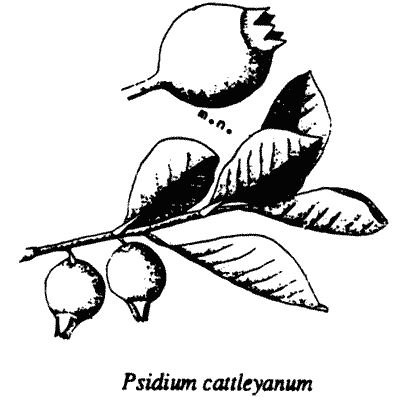
CHERRY GUAVA, ARAÇAZEIRO (Psidium cattleyanum Sab.)
This is a tree of variable size, which, according to growing and climatic conditions, can vary from 1.5 to 5 m in height. The fruits are globose yellow or red berries, tasty, with a diameter of about 1.5 cm. The plant is found in South and Southeast Brazil, Uruguay and Argentina.
This species has a variety with pear-shaped fruits - botanically it is known as Psidium cattleyanum var. littorale (Raddi) Mattos.
BUSH GUAVA, COUNTRY ARAÇAZEIRO (Psidium australe Camb.)
This araçazeiro is found in the field on clay or clay-silica soils, excluding rocky places. It is a sub-bush, 30 cm high, and fruits heavily. Generally it forms stubs and has a lignotuber-type growth. The fruits are delicious, with a yellow-green colour, glabrous, smooth, globose, about 2cm across. The plant is found on the uplands and the central depression of Rio Grande do Sul state, and on the prairies of Santa Catarina State.
ARITICUM (Annona cacans var. glabriuscula Fries)
The Ariticum is a member of the custard apple family (Annonaceae) that is found from Rio Grande do Sul to Rio de Janeiro States on coastal land. It forms a tree about 7m high. The fruit is about 10 cm across. The pulp is tasty and sweet, but with purgative proprieties.
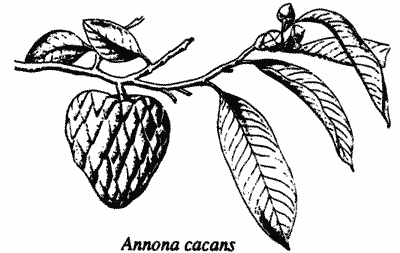
MONKEY BANANA (Porcelia macrocarpa Mart.)
This is another Annonaceae that could be interesting for orchards. It is a branching tree, about 6m in height. It is found along the southern Brazil coast, and on the north of Santa Catarina Island. There is a tree in full production in the Botanic Garden in São Paulo. The pseudo-fruits are found on the extremity of a long and thick peduncle, similar to a banana cluster. Each one is like a small banana fruit.
BAPORETI (Myrciaria rivularis var. baporeti (Legr.)
This member of the Myrtaceae is found only in the west of Rio Grande do Sul state and in northeast Argentina, in a very restricted area. It is a small tree which produces black, globose, smooth, fruits, the size of large grapes. The fruit is sweet and tasty.
BUTIÁ-DA-SERRA (Butia eriospatha (Mart. ex Drude) Beccari)
This palm tree is typical of some upland areas of Santa Catarina State. Its height varies from 3 to 6m, and fruiting is heavy. The fruit is yellow, with the size of a cherry, but with a bigger stone. The pulp has some acidity, but it is tasty, depending on the sugar level of the particular variety. It is used for making home-brewed liquor.
WILD CHERRY(Eugenia involucrata DC)
A tree of medium size, with a height varying from 10 to 15m, but with slow growth, taking a long time to start to produce. It is found in the southern part of Brazil, with an extensive but irregular distribution. The fruit is very similar to the commercial cherry of the Rosaceae, but generally has two seeds, and shows highly characteristic bracteoles at the base. The taste is characteristic and highly appreciated.
FEIJOA, GOIABEIRA SERRANA(Acca sellowiana (Berg) Burr.)
This fruit of the Myrtaceae is native to part of Uruguay, and to Rio Grande do Sul, Santa Catarina, and Paraná states in Brazil. It is a fruit tree that has been improved and cultivated in different places around the world, mainly in New Zealand, which already has 500ha in commercial orchards. The fruit is a green berry, with size and shape variable, and can weigh up to 200g per fruit. The pulp is ice colour, tasty and succulent.
GUAVIROBEIRA, GUABIRABA (Campomanesia guaviroba var. insulae (Legr.)
This fruit of the guava family is found on coastal land, from the north of Rio Grande do Sul state to the south of Santa Catarina Island. The fruit is a orange-yellow berry, very tasty, with size of a jaboticaba fruit (2-3cm), probably the biggest and the best of this genus.
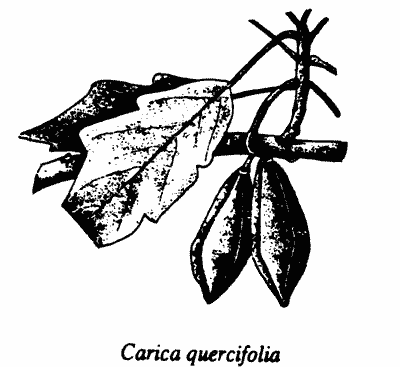
SMALL FOREST PAPAYA (Carica quercifolia Solms.)
This is found from Rio Grande do Sul to São Paulo state. It is a plant of forests and brush woods, and fertile soils. It grows in the Cfa and Cwa climate types (Koeppen classification). It is a small tree from 2 to 4 m of height, with a soft trunk. Its fruits are sweet and tasty, with the form and shape of papaya (pawpaw), but in miniature.
STONE PASSIONFRUIT (Passiflora foetida L.)
This species and its varieties are found over almost the whole of Brazil, except on the seacoast and the Amazon. On the uplands of Rio Grande do Sul and Santa Catarina states this Passifloracea is found in stony places (hence its common name) and in the fields, growing close to grain plants. It has very short trunk and shoots, bushy, but highly productive. The fruits are delicious, with a green colour, a clear tonality and slightly yellow. The surface is very hirsute.
MARACOCK (Passiflora elegans Sims.)
This plant is a robust climbing passionfruit, and is highly productive. It is found in the southern part of Brazil. Its fruits are round, delicious berries, about 2.5-3cm in diameter.
PRAIRIE PEACH (Hexachlamys humilis Berg)
As its common name indicates, it is found in the native prairie, in a large area, but discontinuous. Thus, it is found in the southeast of Rio Grande do Sul, the north of Paraná, and the interior of São Paulo state. The plants grows to around 15 cm in height. It yields 1-3 fruits on each small plant. Its fruits are big and pear-shaped, about 2.5 - 3 cm across. It is similar to Forest Peach. It has a juicy pulp. The plant can be grown in pots.
FOREST PEACH (Hexachlamys excelsa (DC) Mattos)
This fruit belongs to the Myrtaceae family. It is a tree that can reach 10 m in height and is highly fruitful. It is found from the South of Rio Grande do Sul through to São Paulo and Mato Grosso states in Brazil, and also in Uruguay, Argentina, Paraguay and Bolivia. This species has the largest distribution in the genus.
It is found in many soil types, from sandy to clay and stony, but always in fringe forests, hillside forests and rarely in 'cerrado' type forest. It grows in many climates, but mainly in the Cfa and Cwa systems of the Koeppen classification.
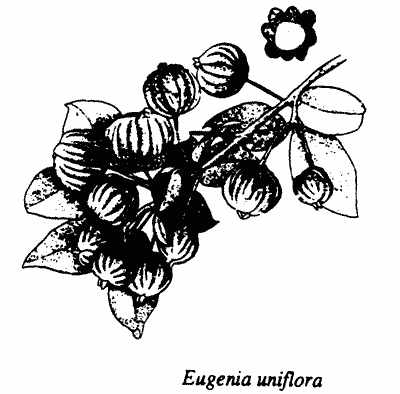
PITANGA, PITANGUEIRA (Eugenia uniflora L)
In fertile soils this tree can reach more than 6 metres in height. It is found on the southern seacoast and uplands of Brazil, and also extends to Uruguay, Argentina and Paraguay.
The fruit is a small red berry of variable size and shape, weighing about 5 g. It has a very thin skin, and low pulp yield due to the size of the seeds. It has a characteristic flavour, sweet and pleasant. It is used also in alcoholic drinks and jellies.
PRAIRIE PITANGA (Eugenia pitanga (Berg) Kiaerskcu)
This small pitanga is found in Rio Grande do Sul state, in Alegrete, Cacequi, São Francisco de Paula, and Santana do Livramento counties, in siliceous and related soils. It reaches a height of around 15 cm. Its fruits are like those of Eugenia uniflora in shape, flavour and colour. It is a hardy plant due to its lignotuberous root.
SETECAPOTES (Campomanesia guazumifolia (Camb.) Berg)
Of the species that have this common name, this is the one that produces the best fruits. It is a small tree from the Araucaria forests. It produces very early in fertile soils. Plants observed in cultivated conditions, with a height of 1.3 m, already produce in abundance. The fruit is a yellow pubescent berry with a flat shape and the size of a plum.
UVALHEIRA (Eugenia pyriformis Camb.)
This is a tree that reaches about 10 m in height. Its geographic distribution extends from Rio Grande do Sul to São Paulo state in Brazil, and to northeast Argentina and eastern Paraguay. The fruit is a yellow-green berry, very juicy, about 15 g in weight.
This species of interest for its timber quality and its abundance in yielding. The fruits are widely used for preparation of jellies.
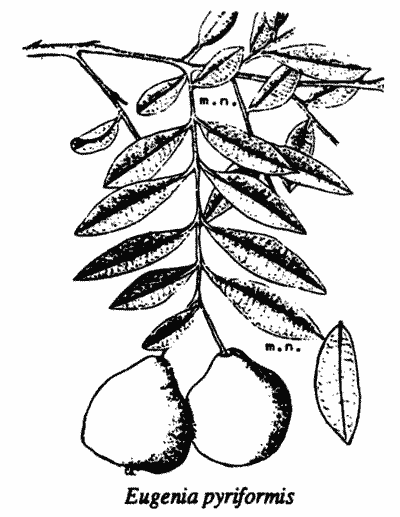
DWARF UVALHEIRA (Eugenia pyriformis var. uvalha (Camb.) Legr.)
This variety reaches 1.2-2.5 m in height. It has a geographic distribution limited to São Paulo state. It is a plant that is in danger of extinction. Rarely it is found cultivated in some back yards, in São Paulo. It has a high density canopy with high and abundant number of shoots. Its fruits are much bigger than the typical species.
BACUPARIZEIRO (Rheedia gardneriana Pl. et Tr.)
This forms a small tree, about 3 m high. It is found in rainforests and Atlantic coastal forests. It is very ornamental and is planted in parks and gardens. Its fruits, each having 1- 2 seeds, are eaten out of hand or used for making jellies. Its distribution extends from Rio Grande do Sul to São Paulo states.
JABOTICABA, JABOTICABEIRA (Myrciaria trunciflora Berg)
This tree, which reaches a height of 10-20 m, is today rarely found in forests, but frequently found in back yards or in small orchards due to its highly quality fruits. These are sold in local markets, but they lose flavour very rapidly.
The fruit is a globose berry, 2 cm in diameter, hairless and black skinned, with 1-3 seeds. It is eaten fresh and also used for making jellies and alcoholic drinks. The tree has the peculiarities of flowering in abundance directly on the trunk and thicker branches, and may flower many times during the year, depending on the climate conditions.
DATE: September 1991
* * * * * * * * * * * * *
